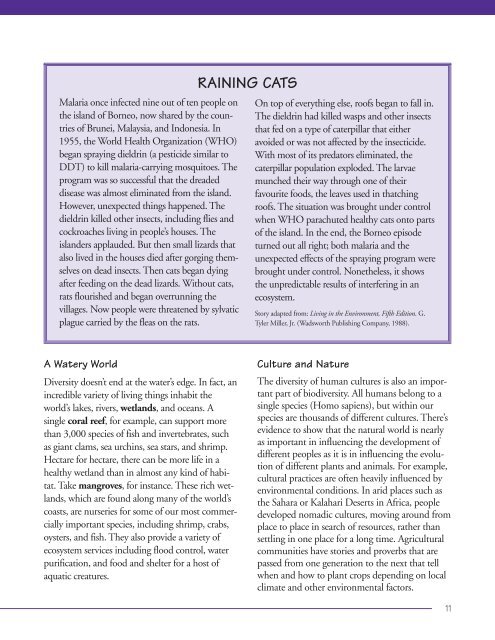EXPLORING BIODIVERSITY: A Guide for Educators Around the World
EXPLORING BIODIVERSITY: A Guide for Educators Around the World
EXPLORING BIODIVERSITY: A Guide for Educators Around the World
You also want an ePaper? Increase the reach of your titles
YUMPU automatically turns print PDFs into web optimized ePapers that Google loves.
Malaria once infected nine out of ten people on<br />
<strong>the</strong> island of Borneo, now shared by <strong>the</strong> countries<br />
of Brunei, Malaysia, and Indonesia. In<br />
1955, <strong>the</strong> <strong>World</strong> Health Organization (WHO)<br />
began spraying dieldrin (a pesticide similar to<br />
DDT) to kill malaria-carrying mosquitoes. The<br />
program was so successful that <strong>the</strong> dreaded<br />
disease was almost eliminated from <strong>the</strong> island.<br />
However, unexpected things happened. The<br />
dieldrin killed o<strong>the</strong>r insects, including flies and<br />
cockroaches living in people’s houses. The<br />
islanders applauded. But <strong>the</strong>n small lizards that<br />
also lived in <strong>the</strong> houses died after gorging <strong>the</strong>mselves<br />
on dead insects. Then cats began dying<br />
after feeding on <strong>the</strong> dead lizards. Without cats,<br />
rats flourished and began overrunning <strong>the</strong><br />
villages. Now people were threatened by sylvatic<br />
plague carried by <strong>the</strong> fleas on <strong>the</strong> rats.<br />
RAINING CATS<br />
On top of everything else, roofs began to fall in.<br />
The dieldrin had killed wasps and o<strong>the</strong>r insects<br />
that fed on a type of caterpillar that ei<strong>the</strong>r<br />
avoided or was not affected by <strong>the</strong> insecticide.<br />
With most of its predators eliminated, <strong>the</strong><br />
caterpillar population exploded. The larvae<br />
munched <strong>the</strong>ir way through one of <strong>the</strong>ir<br />
favourite foods, <strong>the</strong> leaves used in thatching<br />
roofs. The situation was brought under control<br />
when WHO parachuted healthy cats onto parts<br />
of <strong>the</strong> island. In <strong>the</strong> end, <strong>the</strong> Borneo episode<br />
turned out all right; both malaria and <strong>the</strong><br />
unexpected effects of <strong>the</strong> spraying program were<br />
brought under control. None<strong>the</strong>less, it shows<br />
<strong>the</strong> unpredictable results of interfering in an<br />
ecosystem.<br />
Story adapted from: Living in <strong>the</strong> Environment, Fifth Edition. G.<br />
Tyler Miller, Jr. (Wadsworth Publishing Company, 1988).<br />
A Watery <strong>World</strong><br />
Diversity doesn’t end at <strong>the</strong> water’s edge. In fact, an<br />
incredible variety of living things inhabit <strong>the</strong><br />
world’s lakes, rivers, wetlands, and oceans. A<br />
single coral reef, <strong>for</strong> example, can support more<br />
than 3,000 species of fish and invertebrates, such<br />
as giant clams, sea urchins, sea stars, and shrimp.<br />
Hectare <strong>for</strong> hectare, <strong>the</strong>re can be more life in a<br />
healthy wetland than in almost any kind of habitat.<br />
Take mangroves, <strong>for</strong> instance. These rich wetlands,<br />
which are found along many of <strong>the</strong> world’s<br />
coasts, are nurseries <strong>for</strong> some of our most commercially<br />
important species, including shrimp, crabs,<br />
oysters, and fish. They also provide a variety of<br />
ecosystem services including flood control, water<br />
purification, and food and shelter <strong>for</strong> a host of<br />
aquatic creatures.<br />
Culture and Nature<br />
The diversity of human cultures is also an important<br />
part of biodiversity. All humans belong to a<br />
single species (Homo sapiens), but within our<br />
species are thousands of different cultures. There’s<br />
evidence to show that <strong>the</strong> natural world is nearly<br />
as important in influencing <strong>the</strong> development of<br />
different peoples as it is in influencing <strong>the</strong> evolution<br />
of different plants and animals. For example,<br />
cultural practices are often heavily influenced by<br />
environmental conditions. In arid places such as<br />
<strong>the</strong> Sahara or Kalahari Deserts in Africa, people<br />
developed nomadic cultures, moving around from<br />
place to place in search of resources, ra<strong>the</strong>r than<br />
settling in one place <strong>for</strong> a long time. Agricultural<br />
communities have stories and proverbs that are<br />
passed from one generation to <strong>the</strong> next that tell<br />
when and how to plant crops depending on local<br />
climate and o<strong>the</strong>r environmental factors.<br />
11

















